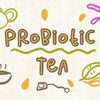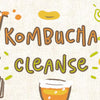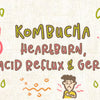Kahm Yeast And Kombucha - Actionable Steps, Tips And Advice
Seeing kahm yeast on your fermenting batch can be worrying. It can appear quickly and take over your brew within in a few days. It's essential to identify what is covering your batch, before acting to remove or prevent excess yeast production. We've built a resource that gives you step-by-step actions and gives answers to all of your questions.
What Is Kahm Yeast?
Kahm yeast is a few different varieties of yeast that are collectively known as kahm yeast. Yeast varieties include Pichia, Hansenula, Debaryo-Myce, Mycoderma, and Candida. Under certain conditions, these yeast varieties consume the sugar in your brew to grow before multiplying rapidly. This may result in yeast covering the top of your brew. All fermented foods are at risk of kahm yeast growth, for example, sauerkraut, kimchi or even sourdough bread.
The definition of yeast: "Yeasts are eukaryotic single-celled microorganisms classified as members of the fungus kingdom." Source: Wikipedia. There are thousands of types of yeast. Kahm yeast is a name given to a group of different yeast species.
When kahm yeast multiply, they may form a film over the top of your ferment that gives it a distinctive look and smell.
5 Signs Kahm Yeast's On Your Brew

If you can see growth on your brew, you need to identify what exactly is growing. Some growth can be allowed and removed, while others will require you to throw the batch away. The appearance can identify kahm yeast, here are a few things to look for:
1. Creamy White In Color - The color of kahm yeast is a creamy white tone. It shouldn't be any other colors. Common mold could appear in yellow, green, and black. Have a look at the top of your brew, or alternatively through the side of you glass jar to inspect the color of growth.
2. A Film Has Formed - It can appear as a film above or attached to the top of your brew. It may start very thin before rapidly becoming thicker as it grows. You can expect this growth to be on top of a mother or baby SCOBY.
3. Bacteria Not Through Your Brew - The yeast and bacteria growth should not be mixed or seen inside your brew. It should only be seen at the top of your brew. Again, have a look through the side of you glass jar to inspect any mixed growth. If you see growth throughout the brew, then it probably is not kahm yeast, instead it’s mold.
4. Texture Of Film - The textured appearance of kahm yeast often resembles beef tripe. It may have little areas or directions of growth on the surface that could cause little ridges to appear on the surface of the yeast. It could also appear like a blister. The thin film may be able to be moved around or pierced under pressure. With air bubbles pushing on the bottom, the kahm yeast may appear to look like a blister.
Is Kahm Yeast Good For You?
Kahm yeast isn't specifically good for you, but nor it is bad for you. Unlike mold, and other bacteria growth kahm yeast growth doesn't mean that you need to throw your whole batch away and start again. Instead, it is recommended to remove the yeast from your brew, before leaving it to carry on fermenting.
Effects Of Kahm Yeast On Your Brew

Once kahm yeast has grown, it may significantly affect the taste. The taste can be rotten and very unpleasant. Therefore necessary to remove.
-
Taste - Kahm yeast changes the taste of your ferment; the change is not very pleasant. It may be only subtle if there is a small amount of yeast present.
-
Smell - It could smell very foul if you have a little bit of kahm yeast. If it's in an enclosed area and you release the top to smell, be warned!
-
Ferment - The fermenting liquid will not stop the kombucha from fermenting. The taste of the ferment may be changed as the kahm yeast will feed on the sugar, allowing for the SCOBY to consume less. The kahm yeast will not grow in the liquid or be in the kombucha, instead of limited to the top only.
-
pH - When kahm yeast grows, it can raise the pH of your brew. Be sure to measure the pH before you drink it. A batch that sits between 2.5 - 4.2 is safe to drink. If the batch is above 4.2, should not be drank. Once the pH has been raised, then there is a chance that other types of harmful bacteria could grow. Therefore if the pH falls out of this critical range, you should dispose of the whole batch.
-
Second Ferment - During the second fermentation stage, yeast and bacteria continues to carry on fermenting, causing carbonation, the distinct fizz of kombucha. If kahm yeast is present in your brew, then it may feed on the sugars, likely stopping you from being able to get a fizzy second ferment.
How To Prevent Kahm Yeast From Growing
When brewing kombucha, it's tough to prevent one specific type of yeast from growing. Unlike other fermented food such as kimchi or sauerkraut, whereby you can add more salt to the brine, when brewing kombucha you can't. Here are a couple of points that you can make sure you implement when brewing your next batch, to try and help to prevent growth.
Temperature - At cooler temperature, kahm yeast won't grow. Keep it within the critical brewing range (68-78ºF). When the temperature exceeds this, then the kahm yeast can eat the sugar in the batch, causing it to grow and multiply.
Cleaning Your Equipment - Before you start brewing, be sure that all of your equipment has been cleaned thoroughly. When cleaning the equipment that comes into contact with kombucha, can’t be antibacterial. Antibacterial soap and cleaning agent residue if left on the surface may kill the SCOBY. Instead, we would recommend cleaning your equipment with boiling filtered water.
What To Do If You Have Kahm Yeast On Your Brew
Once you've spotted that there is kahm yeast on top of your brew, you should check a few things before continuing with the brew. Kahm yeast, if left, may create the perfect environment for bacterial growth, which could be potentially dangerous for you to consume.
-
Check If It's Safe To Drink. Take a pH measurement to see if it's safe to keep on brewing.
-
Be Sure It's Not Mold. Use the mold and kahm yeast identification guides to ensure you've correctly identified the right growth.
-
Remove The Yeast. If you've identified that it is kahm yeast growing, you need to remove the yeast. You can do this by using a non-metal piece of equipment to go into the brew and spoon or scrape the kahm yeast out.
-
Every time you see a build-up of the yeast, you should repeat this process and remove the yeast from your brewing vessel.
Here at Grow You Pantry we grow our own SCOBYs! If you're interested in SCOBYs, or other kombucha accessories check out Our Store for the latest price.
Candida And Kahm Yeast
Candida, or otherwise known as a yeast infection, is a common issue. Symptoms include sugar cravings, itching, sinus infections, white tongue, fatigue, and many others. It's thought that most of us will have a yeast infection or candida at some point.
Candida is where there is an imbalance in the gut. Candida bacteria is naturally occurring in the human body, and it's healthy to have some. The issue comes if there is an overgrowth of candida bacteria. When there is an overgrowth, an imbalance of bacteria can happen, causing symptoms of candida to appear.
Does Kahm Yeast Contain Candida?
No, kahm yeast does not contain the strain of candida that causes yeast infections. Kahm yeast instead contains a species of candida. There are many different varieties of all yeasts and each with different effects on the body.
Don't confuse the two!
Effect Of Kahm Yeast On Candida
Kahm yeast itself shouldn't have much of an impact on candida. The issue may come if you're drinking kombucha. There are a lot of differing opinions on whether you can drink kombucha if you have candida. Check out our kombucha and candida article for the breakdown and possible effects of doing so.
What Does Mold Look Like?
The same type of common food mold that may appear on your old cheese can blight kombucha too. Go with your gut when you see growth on top of your brew: if it looks like mold, dispose of the batch.
Signs That You Have Mold In Your Batch:
-
Color - Mold is commonly green, black, white, or grey. Check to see if your kombucha contains any coloring that looks out of place. Think if this looks like your common food mold to decide if it is or not.
-
Fuzzy - Mold tends to look fuzzy, like freshly spun candy floss. The fuzzy or fluffy edge will be a giveaway.
-
Spots - Does the growth on the top of your batch appear in the spots around the top of your brew? An indicator could be that there are many dots of coloring and fuzzy growth around the top of your ferment.
-
Throughout The Batch - Mold could appear not only on the top of your batch but could be in the batch too. Mold could be mixed in throughout your batch. Kahm yeast only grows at the surface. Check deeper in the batch to see if you have mold colors showing through the glass. This is a clear indicator.
Kombucha with mold on it is not salvageable. Just like if you find mold in a loaf of bread, you throw the whole loaf away - this is how kombucha should be treated too.
Telling The Difference Between A SCOBY And Kahm Yeast
As kahm yeast will grow on top of your brew, a common question can be how to tell the difference between a new baby SCOBY growing and kahm yeast growth. A new baby SCOBY, you'll want to leave to grow and develop before storing in your SCOBY Hotel, whereas kahm yeast, you'll need to remove as soon as possible. To tell the difference can be broken down into a few simple characteristics.
Color - SCOBY will be yellow after absorbing some of the tea. Kahm yeast will be more milky white.
Texture - SCOBY will be slimy to touch, and you pick it up. Kahm yeast doesn't clump together in the same way and will not be a large clump of material.
Smell - SCOBY will smell sweet, fresh, and of the tea it’s sat in. Kahm yeast may smell very bad, like rotten or gone off food.
Taste - SCOBY will be like a gummy bear, rubbery, and chewy. Kahm yeast tastes awful, and you'll want to spit it out!
Common Questions
Is Kahm Yeast Poisonous?
No kahm yeast is not poisonous. You can consume kahm yeast without getting sick. The issues come from the fact that it tastes and smells very bad, and also that when kahm yeast is growing, it could also encourage the growth of more dangerous bacteria. Therefore you should always remove the yeast from the brew.
What Other Food Can Kahm Yeast Infect?
Sauerkraut, kimchi, sourdough, and all other fermented foods can be commonly infested with kahm yeast. Fermented food is more likely to be contaminated with kahm yeast because it could produce the right conditions for optimal growth.
I've Just Eaten Kahm Yeast - What Should I Do?
Nothing! If you've ingested a small amount of kahm yeast, nothing will happen, it may taste bad and make you want to spit it out. But, kahm yeast is not poisonous or harmful to humans.
Is Fermenting Safe?
Fermenting food and eating different ferments is 100% safe. Fermentation has been around as a long-term food storage solution since the creation of the clay pot. Ancient civilizations used brine and other fermentation techniques to store food through the winter months. To be sure you're doing it correctly, look for a book or guide to help you through the process.









